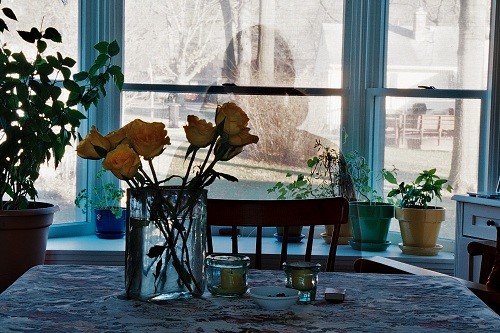 My mother and I sit side-by-side on the couch in her small ranch house. We’re sifting through photographs scattered in a cardboard box I’ve retrieved from her closet. She scrutinizes the faces before her, trying to identify persons who no longer exist. I want to be attentive, but her fragility distracts me. She is so small now, inches shorter than I. Her head seems too large for her diminished frame; this woman who always insisted on good posture has trouble sitting up straight. She sinks into herself, as if disappearing.
My mother and I sit side-by-side on the couch in her small ranch house. We’re sifting through photographs scattered in a cardboard box I’ve retrieved from her closet. She scrutinizes the faces before her, trying to identify persons who no longer exist. I want to be attentive, but her fragility distracts me. She is so small now, inches shorter than I. Her head seems too large for her diminished frame; this woman who always insisted on good posture has trouble sitting up straight. She sinks into herself, as if disappearing.
I flip over a photo and begin writing: names, place, some detail. Yet my efforts feel futile. These spare, flat images will not help me unravel my mother’s history once she is gone.
And then I uncover a striking photograph. My mother’s face—luminous, angles, and shadows—framed in black. Her hair is pulled back in a familiar twist, brushed to the side, defying the strong middle part. Her large almond eyes assess the photographer with compassion and a touch of humor. She holds her wide mouth closed, as though in the next moment she might smile.
“Who took this photograph?” I ask.
“Your father.”
My father, a surgeon, wielded a scalpel with sensitivity and skill. But a camera?
“He wanted to take my photograph right after we’d made love. He said I was so beautiful, even after having four children,” my mother continues.
I can’t recall my father ever complimenting my mother and imagining them having sex is disquieting. Still, I am grateful for her candor, for another glimpse of her.
“How old were you?” I ask, trying to place the photograph in time.
“Forty-six,” she says.
“So we’d all been born then?” I continue, wanting her to be sure of her age, because she looks younger.
“Of course,” she confirms.
I glance back at the photo, but don’t find the presence of children in my mother’s gaze.
My parents had a turbulent relationship, one that consumed rather than sustained them, though my mother tells me they were happy for a long time. During the years of which she speaks, I was aware of a kind of heightened energy around them, a focused intensity that excluded my siblings and me. Later, when I was in a my early teens and their marriage appeared dead for lack of nurture, they seemed to retain the memory of earlier passion, as though that emotion were a kind of phantom limb surviving its own destruction.
For some relationships there is a moment of transformation, an instant after which nothing can be the same. I believe that turning point came when the habitual volatility of my parents’ marriage escalated into violence. I did not witness my father’s assault on my mother, but I was there the next morning.
My mother sat in bed, leaning forward, while my father injected an anesthetic around her spine. No one spoke. I sensed a gentleness in my father I’d never felt and also a profound sadness.
Much later my mother told me that my father had asked her to forgive him, to start over. She said she had agreed, although in her heart she knew it was impossible, because she believed he would never pardon her for being a witness to his worse instincts.
After I have returned home, I take the photograph from my desk, where I’ve placed it for safekeeping. I sit holding the image in the palm of my hand, examining it once again, and, finally, I recognize the timing. If my mother was forty-six, then I was about fifteen. My father took this photograph sometime after his violence, after that watershed.
My mother’s face, framed in black. Her neck and shoulders not visible, as if her face were floating in the void. The effect enhances her beauty, even as it distances her, as though she were spirit, ghost. That blackness feels apt, a metaphor for the gulf between my parents. But perhaps it suggests something else. All that is unknowable. In my parents’ relationship, I saw only the framing darkness. My father, in this photograph, captures something of the light.
—
Margaret L. Whitford‘s essays have appeared in the anthology Good Dogs Doing Good and The Pittsburgh Quarterly. She is co-editor with Sheryl St. Germain of Between Song and Story: Essays for the Twenty-first Century, recently published by Autumn House Press. She is also the winner of the 2011 Best Writing award from the Press Club of Western Pennsylvania.
Photo by Maria Romasco-Moore
